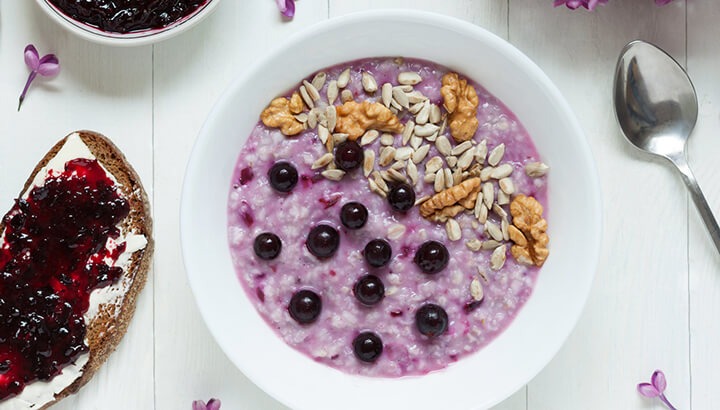There is so much to learn by being observant. As I was adding a handful of fresh blueberries to my morning oatmeal recently, I noticed something unusual. I usually use frozen berries in my oatmeal and I’ve grown accustomed to seeing them “stain” my breakfast.
With the fresh berries, the blue/purple pigment never seemed to leak beyond the fruit itself. Hmmmm…why do frozen blueberries discolor the oatmeal but fresh blueberries do not?
Any experienced baker will tell you that the same thing happens with blueberry muffins. Fresh berries work much better in a muffin… because if you bake with frozen berries, your whole batter will turn purple. Why? Before I answer that question, let’s take a look into the heart of those berries to learn what makes them so special.
Flavonoids — Nature’s Number One Antioxidant
You already know that berries are like the valedictorians of the fruit world. They are lower in sugar than many other fruits, and are loaded with vitamins and nutrients, which are supremely good for you. One of the most important is a group of compounds known as bioflavonoids, which are naturally occurring pigments found in plants that have extremely powerful antioxidant properties.
Bioflavonoids were first identified in 1936 by the Nobel prize-winning chemist Albert Szent-Gyorgi, who was an early pioneer of the health benefits of vitamin C. Originally, flavonoids were simply referred to as “vitamin p,” but since then more than 4,000 of these free radical scavenging substances have been identified. You may have heard of some of the more familiar ones:
- Quercetin (found many vegetables and fruits especially onions, capers, and darkly pigmented fruits and veggies)
- Rutin (found in large amounts in buckwheat, asparagus, and unpeeled apples).
- Hesperidin (found in citrus fruits in the white, bitter inner peel and membranes.)
- Epigallocatechin gallate (concentrated in green tea).
Unleashing the Power of Flavonoids
As you may have noticed from the list above, bioflavonoids really crop up in the skin of plant-based foods. The same is true of blueberries — they are rich in flavonoids called quercetin and myricetin, which are locked in the fiber-rich cellulose skin that encases the berry.
Fresh or frozen, berries are very good for you. But when bioflavonoids are trapped in the cellulose they are not as easily digested and absorbed by the body. But freezing the blueberries causes the water molecules inside the cell to expand into ice crystals which ruptures the cellulose membranes. It’s just like the popping of a water balloon…and all of the bioflavonoid-rich goodness leaks right out. That means that more of those bioflavonoids will be available for your benefit.
Takeaway
Most people think that fresh is better than frozen…and generally speaking, they’re right. I am a huge advocate for fresh fruits and vegetables, but the case of bioflavonoids may be an exception. The pigments leaking out into my oatmeal from the frozen blueberries are a sign that bioflavonoids have escaped from their cellulose prison — their release means that my body can more readily access their benefits.
Besides the bioflavonoids, there are a few other practical reasons that frozen fruit can be a great choice. Frozen fruits are almost always less expensive, and that never hurts. Fruit is a seasonal product and most local fruit seasons are surprisingly short. (Especially here in New England.) So, freezing fruit at the peak of freshness allows people to have access to the nutritional benefits of fruit during times of the year when it is otherwise difficult to get at a reasonable cost.
The flavonoids in blueberries are an extremely beneficial to your health. They are packed with antioxidants and anti-inflammatory that promote cardiovascular health, immune response, and cellular repair. You would be hard-pressed to find any compound in nature that does more to protect you against oxidative stress.
If that isn’t enough, bioflavonoids work synergistically to enhance the benefits of vitamin C. So, next time you are adding frozen blueberries to your morning oatmeal, take a few minutes to ponder those colorful blue and purple pigments swirling in your breakfast cereal. Those vibrant hues will be doing you a world of good.
Take good care,
Dr. Josh









